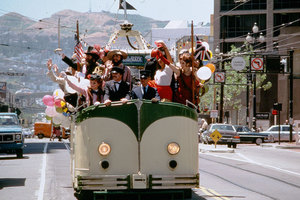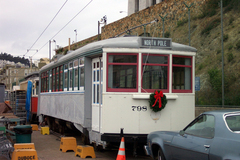Twenty-five years after the reappearance of vintage streetcars in San Francisco, what have we learned? And how can we apply what we’ve learned to improving future operations? Those are the questions Market Street Railway’s leadership raised with its members, and with leaders at Muni over the past year.

Market Street Railway photo.
Quick background: vintage streetcar service in San Francisco, though originally proposed by Muni itself in 1979, only gained real impetus with the successful demonstration project known as the San Francisco Historic Trolley Festival in 1983. (We published a look back at the first Trolley Festival on its 20th anniversary five years ago in our member newsletter, Inside Track. An updated version of that article is available here.) Some of the early leaders of our organization had key roles in the Trolley Festivals, which ended up running for five successful summers, leaving a legacy collection of vintage streetcars in Muni’s hands.
The other legacy of the Trolley Festivals was today’s Market Street Railway itself, which grew from a handful of history buffs to a 1,200-member organization committed to preserving historic transit in San Francisco.
What we’ve learned: Equipment
A quarter-century ago, we assembled whatever kind of safe and operable vintage streetcars we could find. But the Trolley Festivals started as a 40-hour a week operation, duplicating the 8-Market bus line. Today, the F-line is the most popular vintage streetcar line in the country, operating more than 130 hours a week and carrying more than 20,000 riders daily (not counting the many left behind because of overcrowding). Past Muni managements have consistently underestimated the need for additional streetcars to meet rider demand. That is finally being addressed to a large extent by current management.
As mentioned in Sixteen PCCs Out for Renovation Bids, after years of delay, Muni is acting to add sixteen additional reliable PCC cars to the fleet. Yet there is still a shortage, particularly of double-end cars, which are at this point required to operate the long-awaited E-Embarcadero line.
Last year, we asked our members for their views on which remaining unrestored vintage streetcars should be rehabilitated for service. We reviewed the specifics of each car with retired experts and current maintenance staff, focusing on: 1) each car’s suitability for long-term service in today’s busy operation; 2) the car’s operational flexibility; and 3) each car’s history in San Francisco and the size of the investment Muni has already made in it.
Equipment recommendations
We reviewed member and Muni input and then took into account practical considerations, including available plant capacity of the few firms qualified for this kind of restoration work, the challenge of funding additional cars, and our best estimate of future car needs on the E- and F-lines. This process led us to recommend restoration of five double-end vintage cars at this time, with the remaining vintage cars owned by Muni to be held for possible future restoration. We have recommended to Muni that the five double-end vintage cars be funded and renovated in this order of priority, with a firm goal of completing all of them in time for Muni’s centennial at the end of 2012:
1. 1924 Market Street Railway Co. ‘California Comfort Car’ No. 798

Jamison Wieser photo.
This was an easy first choice. It’s the last survivor among 250 home-built cars of this type. Our members saved it from destruction in 1984 and brought it back to San Francisco. It’s as large as Muni counterparts Nos. 130 and 162–a real crowd-swallower. Muni has already invested more than $300,000 in rebuilding the body before the project got mired in bureaucracy. Our volunteers
have since devoted thousands of hours moving the restoration forward. We have now done what we can do, and we have asked Muni to finish the project it started more than 20 years ago. We have specifically requested that this car be the first vintage car to be addressed.
2. 1923 New Orleans Public Service ‘Desire’ car No. 913

John Smatlak photo.
Muni invested $200,000 in 2005 to buy this car from a museum in Southern California. It is complete and still operational, though it admittedly needs refurbishment before going into service. It is a twin of ‘Desire’ car No. 952, but that car is leased to Muni, not owned, and may not remain here permanently. As a full-sized streetcar with a romantic history from San Francisco’s ‘spiritual sister city’, this is a highly appealing car.
3. 1926 Johnstown PA No. 351

Chris Darringer photo.
This car, with its rattan seats and arched ceiling, is a classic American streetcar, almost identical to a group of cars our namesake bought second-hand in the 1930s. It is large and flexible in its operation and has the option to do ‘double duty’ as a regular service car and, when demand allows, as a ‘Teaching Trolley’, fitted out for school classes and family trips with special teaching features by Market Street Railway.
4. 1929 Porto, Portugal No. 189

Market Street Railway photo.
This is one of two single-truck Porto trams that were essential to the success of the first Trolley Festival. Muni spent a couple of hundred thousand dollars building a new chassis for the car and overhauling its truck, motors, and controllers, but the project has
stalled halfway through. As with car No. 798, we have asked Muni to finish what was started and get a return on the investment they have already made.
5. 1927 Osaka, Japan No. 151

Market Street Railway photo.
We took a close look at both Japanese streetcars here in San Francisco and have
recommended that the Osaka car be restored ahead of the other (1927 Kobe-Hiroshima No. 578j). The cars are similar in size, but No. 151 has three sets of doors on each side, whereas No. 578j has only center and rear doors, which will slow down its operation on the street in today’s crowded conditions. Also, No. 151 has four motors to No. 578j’s two, making for faster acceleration on rights-of-way, such as The Embarcadero. Since Osaka is one of San Francisco’s original sister cities, there is an emotional tie as well. It was for that reason that then-Mayor Dianne Feinstein originally requested the donation of this streetcar in 1987.
What’s left?
There are several remaining
vintage cars that could be considered for restoration at a later date.
These include: a second Melbourne tram (No. 586); the small, single-ended 1912 Moscow tram (No. 106); the second Japanese tram (No. 578j); and the 1954 single-end Hamburg tram (No. 3557). And, of course, thanks to a combination of forward thinking by key people within Muni, such as John Sadorra and Tony Tufo, and advocacy and facilitation by Market Street Railway, Muni still has 25 additional PCC streamliners in storage for potential rehabilitation if demand continues to climb beyond all current predictions. Admittedly, some of these PCCs are in poor shape and incomplete, and would serve as parts cars for the others. But there is probably enough material there to complete at least a dozen first-class restored cars, maybe more.
So there are indeed streetcars already owned by Muni that can be restored in future phases to meet demand. By focusing on the five flexible double-ended vintage cars now–along with the PCC project now out for bid–Muni will be able to both expand F-line service to meet surging demand and meet initial E-line operating needs.
The Market Street Railway Blog will keep you apprised of the progress of this proposal, and the Fall 2008 issue of our member newsletter, Inside Track will offer Market Street Railway’s recommendations for operating improvements, based on what is now a quarter-century of historic streetcar operating experience.
We invite you to share your thoughts on the restoration of these and other historic transit vehicles in the comments below.